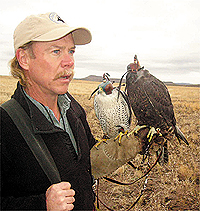"You can't put a money value on your birds. The commitment is really to an entire way of life. The best part of hawking is seeing your birds develop over several seasons."
—Charles Browning, Falconer
By TONY EVANS
For the Express
On a cold November morning Charles Browning stands poised to unleash two avid hunters upon the windswept ponds of Camas Prairie. He scans the horizon of jagged rock above Centennial Marsh for white streaks that mark the aeries of wild raptors before un-hooding two hybrid Peregrine falcons that he has raised by hand.
Practicing the ancient art of falconry for 35 years has given Browning an understanding of avian instinct and biology that has served falconers for at least 4000 years, and recently contributed to the return of the Peregrine falcon from the brink of extinction.
"Working with raptors and following their natural activities opens an entire world to you on the environment," says Browning, who moved to Idaho from California to follow his passion for birds of prey. He lives in Shoshone, where he also raises homing pigeons, and works nights at Da Vinci's restaurant in Hailey in order to leave his mornings free for "hawking" as it is called. "I was quite the naturalist as a kid," he says. "I mean I brought everything home. Reptiles, snakes. Eventually it was birds."
Falconry predates the use of firearms by many centuries and is perhaps the most regulated and complicated form of hunting. It was once the sport of nobility, with arctic gyrfalcons reserved for kings. Becoming a modern falconer is still no easy task. One must undergo two years of training with hawks or kestrels as an apprentice to a tenured falconer before becoming licensed to fly falcons. After five years a person can earn the title of "Master Falconer." With a federal permit, a master falconer can fly golden eagles, top avian predators capable of taking down a pronghorn antelope.
The open, treeless terrain and abundance of public lands in Southern Idaho make this area one of the best for falconry in the country and well known in other parts of the world. Browning enjoys what he calls "a very good working relationship" between the Fish and Game officials and the half-dozen or so falconers that live in the area of Blaine County. "They seem to understand what we are doing, even lending a hand if a bird gets lost."
On this particular morning the hunt or "cast" goes well. Both birds take flight quickly. The older female prairie falcon turns in rising gyres above the marsh, while the younger gyrfalcon male cuts low and fast across the reeds straight for a flock of mallards swimming in the distance. The ducks are pinned to the water by the young male's pass as the female gains altitude. Browning rushes the pond's edge, eventually flushing the ducks, as the female tucks in her wings and falls into a "stoop" or dive, pulling out within feet of the ground and slicing through the flying ducks, talons outstretched, at well over to 100 miles per hour.
Within moments each falcon is feeding upon its kill as Browning rushes to catch up. The birds get their reward of certain vital organs while the ducks are collected for an evening supper. Browning also has recipes for sage grouse, which he also hunts with his birds and a pair of English setters in the Picabo Desert.
"They are the holy grail of falconers. Big birds. Difficult to take down," he says.
His dogs can cover miles of land before they spot and point a grouse, patiently waiting to flush the 10-pound birds.
"It just goes to show you how much things have changed in the last thirty years. Now there is a growing concern about sage grouse habitat, while the falcons which hunt them are no longer endangered."
Recently, Browning took part in a get-together with 35 other members of the Idaho Falconer's Association near Picabo, which meets twice each year to fly birds, hunt and swap stories.
According to Cameron Ellis of the Peregrine Fund at the World Center for Birds of Prey in Boise, "falconers like these contributed birds for captive-breeding programs, as well as a millennia of accumulated knowledge of raptor biology and breeding techniques, to the Peregrine Fund when the species was in decline due to DDT poisoning from agricultural pesticides in the 1970s."
"You can't put a money value on your birds," Browning says. "The commitment is really to an entire way of life. The best part of hawking is seeing your birds develop over several seasons."


 Charles Browning and his falcons get ready for a day of adventure. Photo by Tony Evans
Charles Browning and his falcons get ready for a day of adventure. Photo by Tony Evans



































